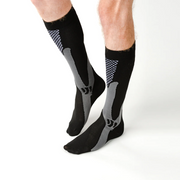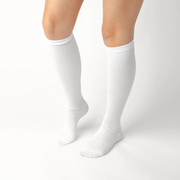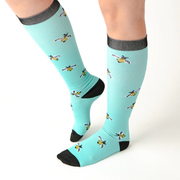Swelling in the lower extremities—often referred to as edema—can result from a variety of health conditions, prolonged periods of standing, pregnancy, or limited mobility. Compression socks for swollen feet apply gentle pressure to the legs, encouraging better blood circulation, lymphatic drainage, and reducing fluid buildup in the lower legs and feet [1]. In this article, we explore how compression therapy works, which compression level is right for you, and how to wear compression stockings comfortably.
How Compression Socks Work
Compression socks—sometimes called compression stockings or graduated compression stockings—are specially engineered hosiery designed to apply firm pressure around the ankles and gradually decrease compression up the leg. This gradient pressure helps:
-
Improve blood flow into the deep veins of the legs and lower extremities,
-
Prevent blood clots (venous thromboembolism) and deep vein thrombosis (DVT),
-
Reduce swelling and fluid buildup in the lower legs and feet,
-
Provide relief for varicose veins, venous ulcers, and achy legs.
By promoting better circulation, compression socks can also enhance performance during exercise or prolonged standing and provide relief for those with health conditions such as lymphedema or chronic venous insufficiency [2].
Selecting the Right Compression Level
Compression levels are measured in millimeters of mercury (mmHg). The appropriate compression level depends on your specific needs and medical advice from a healthcare provider or professional fitting specialist [3]. Common compression levels include:
-
Mild Compression (8–15 mmHg): Ideal for pregnant women experiencing mild swelling in the feet and ankles or for everyday wear to reduce achy legs.
-
Moderate Compression (15–20 mmHg): Often recommended for mild varicose veins, managing swelling, and improving circulation during extended periods of standing or sitting.
-
Firm Compression (20–30 mmHg): Used to prevent blood clots and venous ulcers, or to manage more significant swelling and post-surgical recovery.
Before purchasing new stockings, it is essential to fit correctly. A professional fitting at a medical supply store can ensure the socks or thigh-high stockings provide the right amount of pressure without causing skin irritation or excessive tightness.
Who Can Benefit from Compression Socks?
-
Pregnant Women: Hormonal changes and fluid retention during pregnancy can lead to swollen feet and lower legs. Wearing compression stockings daily can help manage swelling and reduce discomfort (Mayo Clinic Q&A) [4].
-
Healthcare Providers & Office Workers: Individuals who stand or sit for extended periods—such as nurses or call-center employees—often experience achy legs and fluid buildup. Graduated compression stockings support better blood circulation and reduce fatigue.
-
Travelers & People with Limited Mobility: Extended periods of sitting (e.g., long flights or car rides) increase the risk of DVT and swelling. Compression socks offer gentle pressure to enhance circulation and reduce the risk of blood clots.
-
Athletes & Fitness Enthusiasts: Wearing compression socks during exercise can enhance performance, speed up recovery, and reduce muscle soreness by promoting better blood flow and lymphatic drainage [5].
Practical Tips for Wearing Compression Stockings
-
Put Socks on First Thing in the Morning: Swelling is typically lowest after sleeping, making it easier to pull stockings on and ensuring maximum effectiveness throughout the day.
-
Choose the Right Material: Look for breathable, moisture-wicking fabrics that prevent skin irritation caused by sweating. Anti-embolism stockings and compression sleeves made of nylon-spandex blends are popular for everyday use.
-
Wear Them Correctly: Smooth out any wrinkles and ensure the socks are snug but not painfully tight. If you experience numbness or increased pain, remove them and consult a healthcare provider.
-
Gradual Introduction: If you’re new to compression therapy, start by wearing mild compression socks for a few hours a day and gradually increase to wearing compression for all-day use.
-
Rotate Between Knee-High and Thigh-High Styles: Thigh-high compression stockings may provide better support for individuals with significant varicose veins or venous ulcers. However, knee-high socks are often easier to put on and more comfortable for everyday wear.
Addressing Common Concerns
-
Skin Irritation & Proper Fit: Ill-fitting stockings can cause chafing or cause “tourniquet” effects above the calf. A professional fitting helps you select the correct size and reduces the risk of skin irritation.
-
Managing Swelling vs. Reducing Swelling: While compression therapy significantly helps manage swelling, treating the underlying cause—such as heart disease, kidney issues, or liver conditions—may require medical intervention. Always seek advice from a qualified healthcare provider.
-
Compression Therapy vs. Over-the-Counter Remedies: Unlike general over-the-counter remedies, graduated compression stockings are clinically proven to improve blood circulation and prevent blood clots, making them a preferred choice for chronic conditions or long periods of immobility [6].
Where to Buy Compression Socks
Compression therapy products are available at specialty medical supply stores, pharmacies, and online retailers. When purchasing online, verify the brand’s reputation and look for clear sizing instructions. Some medical supply stores also offer professional fitting services to ensure the compression level and fit match your needs.
Conclusion
Compression socks for swollen feet offer a practical, evidence-based solution to improve blood flow, reduce swelling, and prevent complications like venous ulcers and deep vein thrombosis. By choosing the correct compression level, fit, and fabric, and by wearing compression stockings consistently, you can experience relief from achy legs and manage fluid buildup effectively. For personalized advice, consult your healthcare provider or a professional fitting specialist.
References
[1] Mayo Clinic. “Compression stockings: Do they work?” Mayo Clinic Q&A.
[2] O’Meara, Sandra, et al. “Compression therapy for venous leg ulcers.” Cochrane Database of Systematic Reviews, 2018.
[3] Partsch, Hugo. “Referral Compression Dressings: How to Adjust and Fit.” Journal of Medical Devices, 2020.
[4] Mayo Clinic. “Edema (Swelling).” Mayo Clinic, 2022.
[5] Born, David-Paolucci, et al. “Influence of Compression Socks on Running and Recovery.” Sports Medicine, 2019.
[6] Nelson, Elaine, et al. “Graduated Compression Stockings: A Review of Their Clinical Use.” Journal of Vascular Surgery, 2021.
 Active Compression
Active Compression
 Plain Compression Socks
Plain Compression Socks
 Colourful Compression
Colourful Compression

